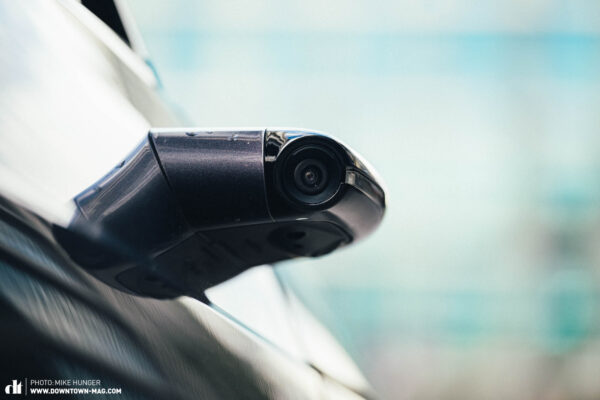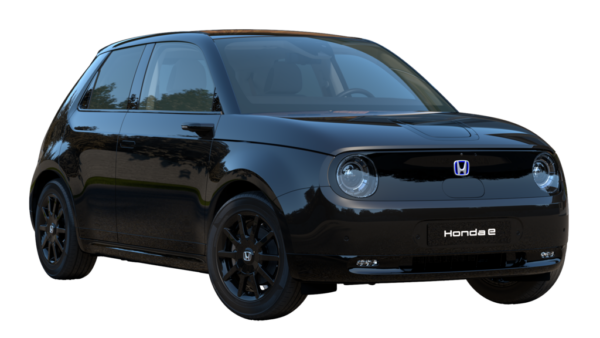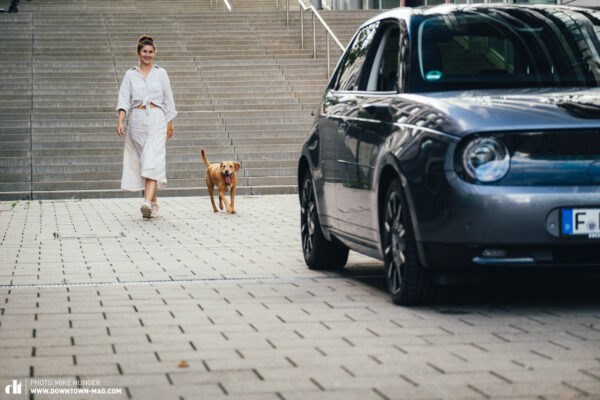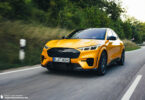Love at first sight? The Honda is so retro and charming, you might be fooled into thinking it came to us straight from the Art Deco era. But how smart is the Japanese car really, and why would you rather hang out in it than in your own lounge? We put the € 41,200 EV through its paces to find out what it’s capable of.
You can find all electric Cars in our big EV special “Which is the best electric car of 2023?“, where you can also check out our personal EV buyer’s guide – free of charge!

The designers’ brief for the Honda e? Charisma, charisma, charisma, and more charisma! The Honda must be the most charismatic of all EVs. Despite having come onto the market just two years ago in 2020, the Honda is already establishing itself as an icon amongst electric vehicles, easily slotting between the likes of the VW Beetle and Porsche 911. The round button lights at the front and rear make it endearing, yet the 17″ alloy rims and the charging port located centrally on the front give it a sporty look. This is not an electric car that tries to win you over with impressive specs and performance figures, but rather by appealing to you emotionally – and it succeeds.



The Honda e in detail – A drive-in cinema?
At first glance, the Honda e looks rather small – just 4 metres long, 1.75 metres wide and 1.5 metres tall – making it ideal for inner city navigation but not for those sitting on the back bench. Things will get tight for your passengers in the rear if they’re more than 1.8 m tall, and our office dog Leo wasn’t particularly happy in the 171 litre trunk. With the backrest of the bench at the rear, you can only fold down the complete thing, increasing the luggage capacity to 861 litres. On the upside, the compact dimensions of the Honda e make for a tiny 9.2 m turning circle, easily letting you turn around on a two-lane country road. Fortunately, you won’t have to manoeuvre it around too much when stopping to charge thanks to the front and centre charging port, so you can simply approach the charging station head on. It also looks like a new interpretation of a muscle car cold air intake!

Instead of feeling cramped, the interior of the Honda e feels roomy despite its compact size – the large windows and panoramic roof create an open feeling. Added to that are the wood grain trim on the dashboard and centre console, and the slightly rougher texture of the material on the seats and door panels. Together with the downlights behind the sunroof, the colour accents in the stitching, the colour-matched seat belts, and the 3 large screens on the dashboard, the interior of the Honda e creates a lounge feeling that invites you to just hang around. The Honda e emphasises this by way of the plug ports in the centre console beneath the aircon: besides a 12 V and USB port, you’ll also find an HDMI port and 230 V outlet like you would in your house. So, what’s to stop you from plugging in your PlayStation or Apple TV box like we did? That way you can pass the charging time while playing games or watching your favourite series. Obviously, for safety reasons, the Honda e locks the streaming function while you’re driving.

Despite the five large displays confronting the driver, the Honda e is intuitive to operate. Integrated into the high-quality wood grain material of the centre console, between the front seats, you’ll find four buttons: P, R, N and D. Below that, you’ll find controls to activate regenerative braking for one-pedal driving and toggle the driving modes. Further up is the aircon, and above that is a volume dial and a Home button, among others. It doesn’t take a degree in aerospace engineering to figure out what these are for, and the haptic feedback of the physical buttons is more natural than that of touch buttons, which you’ll find plenty of in other EVs.
The interior of the Honda e – Screens as far as the eye can reach!
The dashboard of the Honda e consists of a whopping 5 screens: 3 for infotainment, 2 as for the side rear-views, and 1 for the central rear-view. Instead of mirrors, the outside of the Honda e is dotted with cameras. The fins on the side, one on the left and one on the right, don’t just function as indicators but also contain 2 cameras each. One of them faces rearward for the two rear-view screens, and the other faces down, giving a 3D view when parking. Added to these are centrally positioned front and rear cameras. The one at the rear provides the central rear-view if you want. The dimmer lever on the central rear-view mirror/camera lets you switch between the analogue and digital version, so you can still have a clear view of what’s going on behind you no matter how much luggage you’ve got stuffed into the back and obstructing the view of the analogue mirror. Brilliant! It can be adjusted for differently-sized drivers like any rear-view mirror – doing so isn’t necessary for the side rear-view cameras/screens. Moreover, the cameras’ wide-angle view promises to eliminate any blind spots. However, the image gets quite grainy at night and in poor light conditions.


The three infotainment screens are evenly distributed with one in front of the driver, one in the centre, and one in front of the passenger. While the digital speedometer is relatively fixed in its configuration, what’s displayed on the other two screens can be swapped around. As such, the passenger has as much information and control at their disposal as the driver, living out the full potential offered by digitalisation. The tabs of the menu are big and easy to tap while driving. Besides the previously mentioned HDMI streaming option, you can also have an aquarium as a screensaver when stopped. It’s more of a gimmick than a function, but it underlines the electric car’s zen character.
Honda e – UNcustomise it!
There are just two Honda e variants available, the only difference between them being the rims. The basic version comes with 16″ rims for € 39,900, whereas the model above that – the one we tested – rolls on 17″ rims, setting you back by an additional € 600. You can choose from a vast range of optional extras like decorative trim, backlit lettering, and child seats, but you’ll quickly notice that the essentials remain the same. From the battery and motor, seat and steering-wheel heating, rear-view cameras, automatic Park Assist, and LED headlights to a host of safety systems, it’s all standard. You get all the bells and whistles with the entry level model, which is not something you see often.


Honda e – Timeless style but outdated tech
According to Moore’s Law, the number of transistors on microchips doubles every 18 months. So, computing power has more than doubled since the Honda e was introduced to the market in March of 2020, and it’s noticeable in the charming little EV. The infotainment system in the Honda e can be quite slow, and the navigation doesn’t always find points of interest. This gets particularly annoying when using voice commands, so we recommend just saying the address, which worked reliably. It’s not just the infotainment layout that makes a somewhat outdated impression but also the assist functions that are no longer state-of-the-art. For example, the Adaptive Cruise Control has trouble recognising vehicles ahead when you’re driving around a bend, occasionally even when it’s as shallow as a highway offramp. In that case, it will brake sporadically and then accelerate to catch back up. Furthermore, the Lane Keep Assist only works at speeds from 60 km/h, and then only if the road markings are white and clearly visible. You’ll want to grab the steering wheel yourself when driving through construction sites. It’s unclear to what extent a software update can remedy these issues or whether it’s limited by the capabilities of the hardware. Either way, the Honda feels most at home in the urban jungle where you don’t need these functions all that much. There, the young icon attracts as much attention with its button eyes as a VW Beetle with a just-wed couple pulling a string of tin cans behind it, or a golden limousine, though without making racket or seeming smug while emitting greenhouse gases.




Driving the Honda e – Rear-wheel drive for a hallelujah?!
Before you can drive, you must charge, which the Honda e can do at a power of 56 kW in optimal conditions. Realistically, you’re unlikely to achieve a higher charging power than 50 kW, even on a balmy summer’s day, which the local charging infrastructure will thank you for. Because you’ll be a regular at the charging stations without putting the infrastructure under too much strain. On average, charging from 20–80% capacity takes about 35 minutes. According to the navigation system, a full charge gives you a 200 km range. From our experience, this turned out to be closer to 160 km, depending on your driving style and the weather. If you must charge the Honda at night, you might have trouble finding the button to open the hatch to the charging point. The illuminated strip on the top end of the hatch doesn’t help here either. However, the light strip does allow you to see from afar whether the 35 kWh battery is full or still charging.
Driving the Honda e in the normal mode, it feels rather tame, though not underpowered – perfect for swimming along with its internal combustion driven counterparts in rush-hour traffic. If the roads are clear and you’re in a hurry, we recommend switching to Sport mode. In that case, the motor is radically more responsive when you step on the accelerator, making the Honda e feel lively and playful. If you like accelerating out of the corners, you’ll have to be careful as the rear-wheel driven, compact EV has a tendency to spin its wheels and oversteer. Winding roads are a lot of fun, and the Honda e proves to be very stable. It’s not quite as planted as the Polestar 2, yet it doesn’t have as much body roll as the KIA EV6.
The onboard navigation system of the Honda e isn’t the most helpful when planning longer trips: it simply indicates nearby charging stations instead of looking for options along your desired route. This further underlines the fact it isn’t made for long hauls.
Considering the price point of more than € 40,000, the Honda e is an unsensible car. That said, it has the potential to usurp the iconic rank of the Mini or function as a back-up vehicle, parked in the hidden garage of your luxury mobile home. Its handling and small turning circle also predestine it as an inner-city runabout. For instances like that, its range is sufficient and the outdated assist functions are hardly needed.

Our conclusion on the Honda e
The iconic design of the Honda e just exudes good vibes – you can’t help but smile when you see it – and the agile handling is a lot of fun, too. Unfortunately, the assist functions, slow infotainment system and hefty price tag might reduce your grin to a smile. However, the Honda e proves that even compact cars can have sensible features like the rear-view cameras. It’s a car for aesthetes, architects, and doctors’ daughters who value sporty handling and unique looks.

Tops
- cool, charismatic design
- charging port front and centre
- lounge feeling
- agile handling
Flops
- slow infotainment system
- expensive
- unreliable and imprecise assist functions
- navigation system doesn’t include charging stations en route
All tested e-cars: City Transformer Prototyp | Fiat 500e | Honda e | KIA EV6 | Opel Rocks E | Polestar 2 | Porsche Taycan | Smart EQ Forfour | Tesla Model 3 Dual Motor Long Range | VW ID.3 | VW ID.BUZZ
Words: Julian Schwede Photos: Mike Hunger







